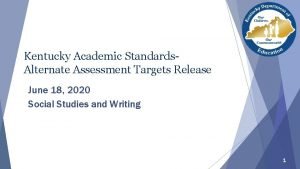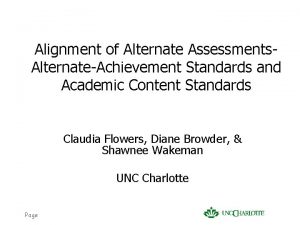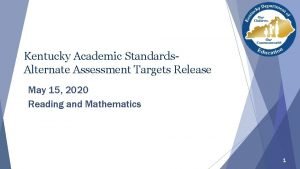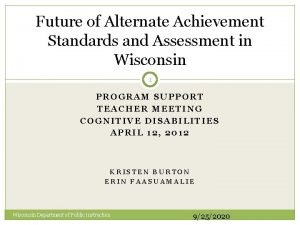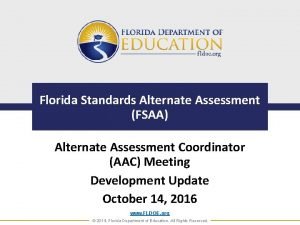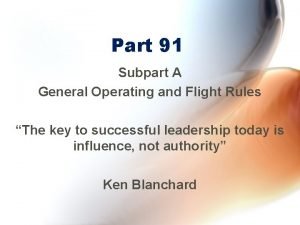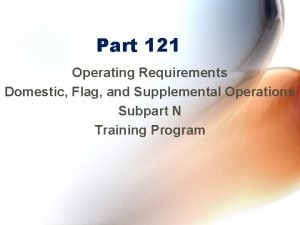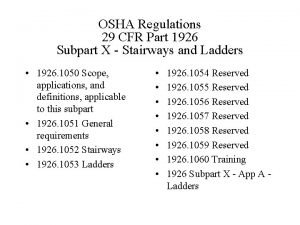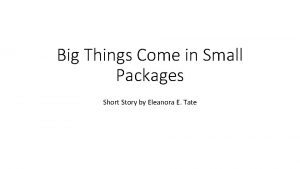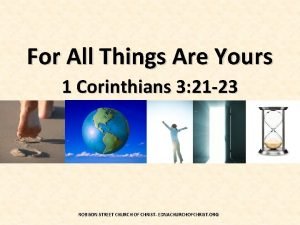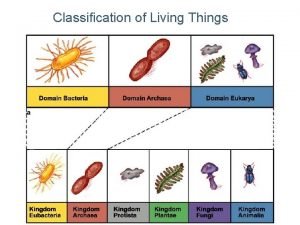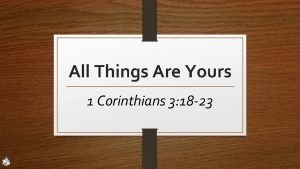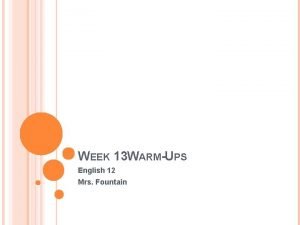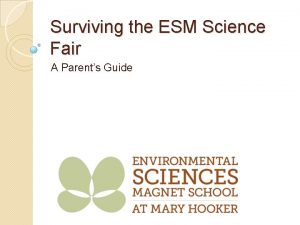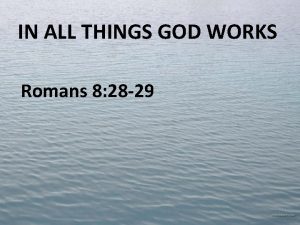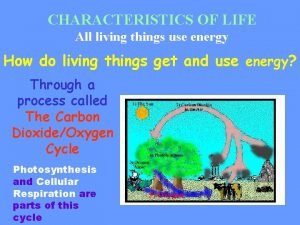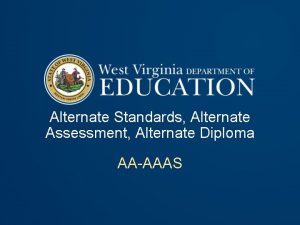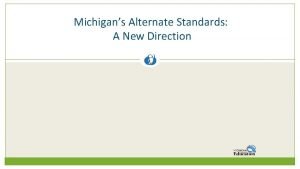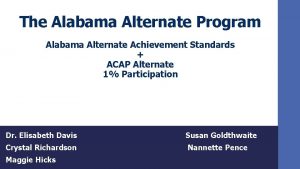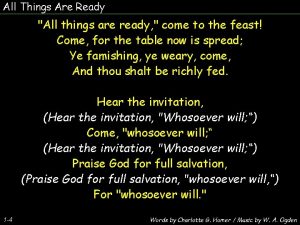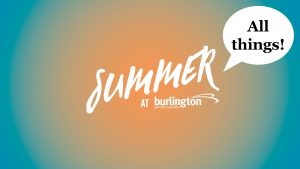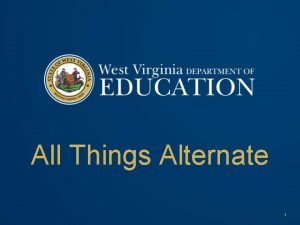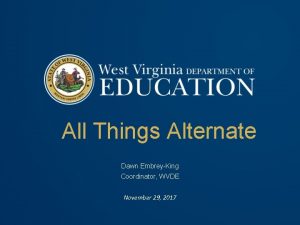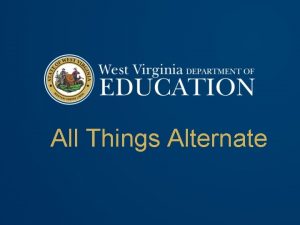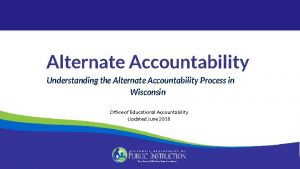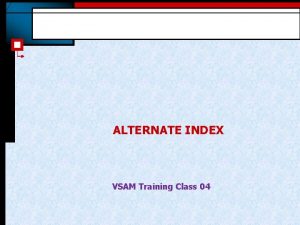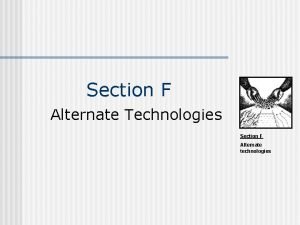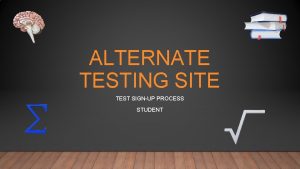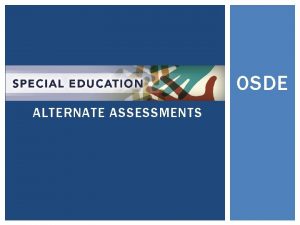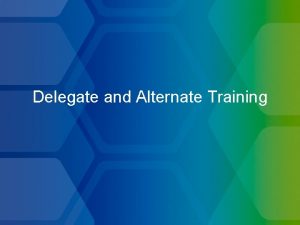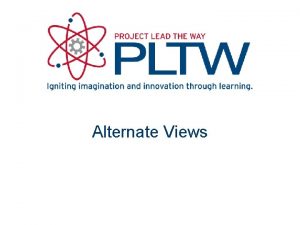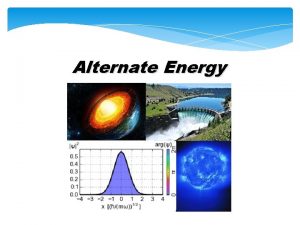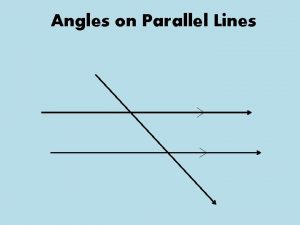All Things Alternate Part 2 1 Alternate Standards




























- Slides: 28

All Things Alternate Part 2 1

Alternate Standards, Assessment and Diploma Timeline Year Alternate Standards 2017 -2018 -2019 -2020 -2021 Current Next Gen Standards (New Standards) Policy 2520. 16 Alternate Academic Achievement Standards 9 th grade cohort Alternate Assessment Current Alternate Summative Assessment (DLM) Diploma Type Modified Diploma New Alternate Summative Assessment Alternate Diploma 2

Special Education Documents/Updates Every Student Succeeds Act (ESSA)- December 2015 Federal Law passed by Congress Dear Colleague Letter- November 2015 Clarified FAPE for Students with Disabilities ESSA Frequently Asked Questions (FAQs)- 2016 National Down Syndrome Congress 3

0’s 198 Functional Life-Skills Curriculum to participate fully in community 1990’s INCLUSION with same age peers in home school 2015 INVOLVEMENT and PROGRESS in General Education Curriculum for ALL students 4

Alignment General Education Curriculum State Approved Grade Level Content Standards (Alternate) 5

Alignment The process of matching educational components of: • Standards • Instruction • Assessment 6

When Education Components Align General Curriculum (state standards) Assessment Instruction 7

When IEPs Promote Alignment General Curriculum (state standards) IEP Instruction (skills taught) Assessment (state test) 8

Alignment for 3 rd Grade Math Standard Multiplication is a third-grade standard Instruction to multiply by 1 -12 Multiplication items (state alternate assessment) 9

Instruction Not Aligned to Standards Curriculum: Multiplication Instruction on IEP skill: Telling time State alternate assessment: Combine sets 10

3 rd Grade Math Instruction Aligned to Standard Third-grade standard: Multiplication instruction: Combining Sets State Alternate Assess Combining Sets 11

Aligned IEP Goal Third-grade math standard Skills for IEP: Identify Numerals with AAC device; count with oneto-one correspondence Instruction on creating and combining sets State alternate assessment: Combine sets 12

IEP Includes Life Skills and the General Curriculum 10 th grade academic standards IEP Instruction State Alternate assessment Life skills curriculum 13

Writing IEPs that Align to State Standards 1. Become familiar with the state standards. 2. Become familiar with the alternate achievement standards. 3. Keep the planning student focused towards graduation and post school opportunities. 4. Consider both specific goals and broad access goals. 5. Ask the question “Is it really academic? ” 14

Standards-Based IEPs and Access Goals Promote goals for the strategies students need to develop to learn the general curriculum content. • When given a graphic organizer, Bobby will identify key details in a story/text… (doesn’t matter the content area) 8 out of 10 times as documented by student work samples and teacher made assessment. Goals help focus priorities within the general curriculum for students who take the alternate assessment. • When presented with a detail (picture of character or setting) from the text and a distractor that is not-text related, Maria will select the detail with 50% accuracy as documented by student work samples and teacher made assessment. 15

16

Determining Priority Areas 1. Are we preparing the student to be more independent and to improve his quality of life? 2. How can we broaden his/her world? 3. How do we facilitate regular and ongoing interactions with typical peers and promote social inclusion? 4. What instructional activities will enable the student to gain self-dependence and control over the environment? (Sarathy, 2014) 17

Priority Area Considerations 1. The frequency the skill will be used grade level to grade level; 2. Whether the mastery of the skill will increase independence; and 3. Whether the skill will assist the student in controlling his own environment. 18

ESSA Requirement #1 for the Alternate Diploma: Be Standards Based Breadth- the number of grade-level content standards that are addressed Depth- the number of objectives considered within any of the content standards Complexity- the requisite skills needed for successful completion of the material covered by the standards. 19

Meaningful Partial Participation By appropriately including students with the most significant cognitive disabilities through manipulations of breadth, depth, or complexity, at least some subset of gradelevel content standards will be within the student’s educational experience 20

Example of Adapted Grade-Aligned Content • Multi-grade class reading The Broken Shard. • State Standards for grades 6, 7, and 8 include a focus of students being able to (a) analyze how a theme is developed over time with plot and characters and (b) summarize the text. • Students with SCD accesses the text through a teacher or peer read aloud, technology, or by independently reading the simplified text. • Student working towards grade level achievement- write about the story using details to support points made. • Student with SCD working toward alternate achievement may prepare a similar essay by filling in a graphic organizer using words or pictures. 21

Example of Adapted Grade-Aligned Content Although performance expectations are different for students with significant cognitive disabilities, the content is the same through the use of: • The same novel • The same general activity (reading and writing about the text), and • The same state content standards (analyzing theme). 22

Systematic Instruction and Instructional Strategies For all instruction, there are three major decisions that must happen before the instruction begins: ØWhat will be taught? ØHow will it be taught? ØWhere will it be taught? For students with significant cognitive disabilities, this decision breaks the standards down to their core learning targets and brings them to the application and functional living level while continuing to be challenging and grade-level core aligned. 23

Best Practice Document Social Studies (PE/Health and the Arts to come) 24

Course Codes • All 9 th grade students that are currently on Alternate Assessment, being instructed on the alternate standards, should have already had their schedules updated with the new course codes. • The course codes have been developed and can be found on the WVEIS website under the Support Tab (Course Code Change Document 2017 -2018). • District WVEIS personnel and/or school counselors have been making the changes to student’s schedules. It is a district decision about particular digits within the course codes (WVEIS course codes are 4 digit numbers), districts/schools add the remaining digits. 25

Current Middle School Example from WV District 76110 J- Social Skills 76100 J- Daily Living Skills 31080 J- Work Skills 48100 J- Reading Support 68070 - Health (related arts) 59117 - Library Skills (related arts) 26

Better Middle School Example ENGLISH LANGUAGE ARTS 8 Alternate Standards MATH 8 Alternate Standards SCIENCE 8 Alternate Standards WV STUDIES 8 Alternate Standards ART Alternate Standards PHYS ED 8 Alternate Standards DAILY LIVING SKILLS 4008_ J or K 3008_ J or K 6008_ J or K 7946_ J or K 6608_ J or K 7610_ J or K • The _ in the 5 th digit is decided by LEA • The 6 th digit is determined by Special Education Category which is found on the course code document in WVEIS 27

Dawn Embrey-King Coordinator, WVDE dembreyking@k 12. wv. us 28
 Seven life processes grade 4
Seven life processes grade 4 Ky alternate assessment standards
Ky alternate assessment standards Alternate standards alignment
Alternate standards alignment Kentucky alternate assessment standards
Kentucky alternate assessment standards Alabama alternate achievement standards
Alabama alternate achievement standards Florida standards alternate assessment
Florida standards alternate assessment Basic vfr minimums
Basic vfr minimums Cross country nav log
Cross country nav log Part 121 pic requirements
Part 121 pic requirements Name all the lines name all the segments name all the rays
Name all the lines name all the segments name all the rays Customer service standards table
Customer service standards table Difference between living and non living organisms
Difference between living and non living organisms Osha part 1926
Osha part 1926 Small things come in big packages
Small things come in big packages Part whole model subtraction
Part whole model subtraction Unit ratio definition
Unit ratio definition Part part whole
Part part whole What is a technical description
What is a technical description Bar prats
Bar prats The part of a shadow surrounding the darkest part
The part of a shadow surrounding the darkest part Minitab adalah
Minitab adalah All things are yours
All things are yours 8 levels of classification for all living things
8 levels of classification for all living things Tissues group together to form
Tissues group together to form 1 corinthians 3:18-23
1 corinthians 3:18-23 All things considered being a senior offers a student
All things considered being a senior offers a student All things fair parents guide
All things fair parents guide In all things god works
In all things god works Life cycle of all living things
Life cycle of all living things

